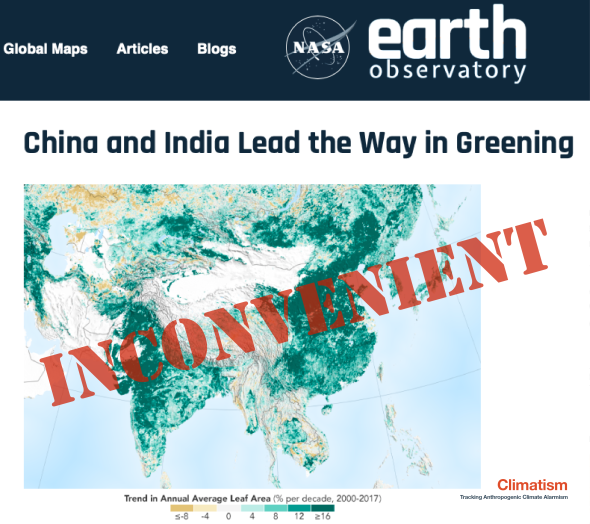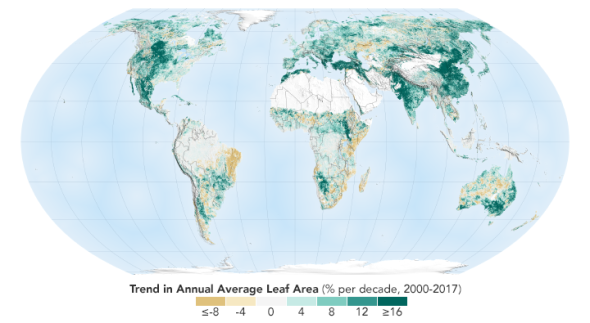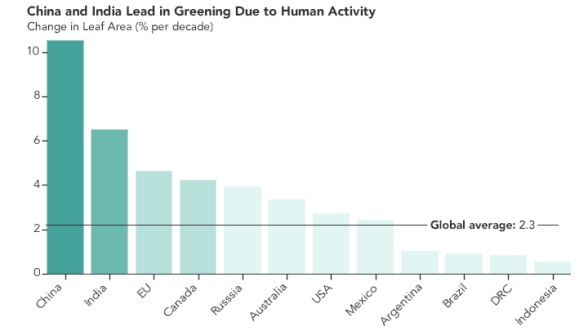INCONVENIENT : ‘The World Is Literally A Greener Place Than It Was Twenty Years Ago’ – NASA
Posted: April 25, 2019 Filed under: Alarmist media, Carbon Dioxide, Climate Change, Climatism, CO2, Environmentalism, Fact Check, Government Grants/Funding, NASA, Satellite Data | Tags: Carbon Dioxide, carbon dioxide emissions, Carbon Dioxide Fertilisation, China, Climate Change, Climatism, CO2, forestry, Global greening, Global Warming, India, nasa, NASA Earth Observatory, Science and Environment 1 Comment“The fact that an opinion has been widely held is no evidence whatever that it is not utterly absurd; indeed in view of the silliness of the majority of mankind, a widespread belief is more likely to be foolish than sensible.” – Bertrand Russel
***
DON’T expect to see this ‘good’ environmental news on the mainstream media anytime soon.
WHEN you’re in the business of demonising carbon dioxide and frightening the Thunberg’s kiddies for political and ideological ends, such good news comes as a rather unwelcome message!
China and India Lead the Way in Greening
The world is literally a greener place than it was twenty years ago, and data from NASA satellites has revealed a counterintuitive source for much of this new foliage. A new study shows that China and India—the world’s most populous countries—are leading the increase in greening on land. The effect comes mostly from ambitious tree-planting programs in China and intensive agriculture in both countries.
Ranga Myneni of Boston University and colleagues first detected the greening phenomenon in satellite data from the mid-1990s, but they did not know whether human activity was a chief cause. They then set out to track the total amount of Earth’s land area covered by vegetation and how it changed over time.
The research team found that global green leaf area has increased by 5 percent since the early 2000s, an area equivalent to all of the Amazon rainforests. At least 25 percent of that gain came in China. Overall, one-third of Earth’s vegetated lands are greening, while 5 percent are growing browner. The study was published on February 11, 2019, in the journal Nature Sustainability.
The maps on this page show the increase or decrease in green vegetation—measured in average leaf area per year—in different regions of the world between 2000 and 2017. Note that the maps are not measuring the overall greenness, which explains why the Amazon and eastern North America do not stand out, among other forested areas.
“China and India account for one-third of the greening, but contain only 9 percent of the planet’s land area covered in vegetation,” said lead author Chi Chen of Boston University. “That is a surprising finding, considering the general notion of land degradation in populous countries from overexploitation.”
globalgreening_tamo_2017
This study was made possible thanks to a two-decade-long data record from the Moderate Resolution Imaging Spectroradiometer (MODIS) instruments on NASA’s Terra and Aqua satellites. An advantage of MODIS is the intensive coverage they provide in space and time: the sensors have captured up to four shots of nearly every place on Earth, every day, for the past 20 years.
“This long-term data lets us dig deeper,” said Rama Nemani, a research scientist at NASA’s Ames Research Center and a co-author of the study. “When the greening of the Earth was first observed, we thought it was due to a warmer, wetter climate and fertilization from the added carbon dioxide in the atmosphere. Now with the MODIS data, we see that humans are also contributing.”
China’s outsized contribution to the global greening trend comes in large part from its programs to conserve and expand forests (about 42 percent of the greening contribution). These programs were developed in an effort to reduce the effects of soil erosion, air pollution, and climate change.
Another 32 percent of the greening change in China, and 82 percent in India, comes from intensive cultivation of food crops. The land area used to grow crops in China and India has not changed much since the early 2000s. Yet both countries have greatly increased both their annual total green leaf area and their food production in order to feed their large populations. The agricultural greening was achieved through multiple cropping practices, whereby a field is replanted to produce another harvest several times a year. Production of grains, vegetables, fruits and more have increased by 35 to 40 percent since 2000.
countrieschart_tamo_2017
How the greening trend may change in the future depends on numerous factors. For example, increased food production in India is facilitated by groundwater irrigation. If the groundwater is depleted, this trend may change. The researchers also pointed out that the gain in greenness around the world does not necessarily offset the loss of natural vegetation in tropical regions such as Brazil and Indonesia. There are consequences for sustainability and biodiversity in those ecosystems beyond the simple greenness of the landscape.
Nemani sees a positive message in the new findings. “Once people realize there is a problem, they tend to fix it,” he said. “In the 1970s and 80s in India and China, the situation around vegetation loss was not good. In the 1990s, people realized it, and today things have improved. Humans are incredibly resilient. That’s what we see in the satellite data.”
NASA Earth Observatory images by Joshua Stevens, using data courtesy of Chen et al.,(2019). Story by Abby Tabor, NASA Ames Research Center, with Mike Carlowicz, Earth Observatory.
*
GLOBAL GREENING…
“A quarter to half of Earth’s vegetated lands has shown significant greening over the last 35 years largely due to rising levels of atmospheric carbon dioxide, according to a new study published in the journal Nature Climate Change on April 25.” – NASA
NASA previously reported on the ‘greening of the earth’ thanks to the CO2 ‘fertilisation’ effect.
HOWEVER, such good news was again carefully omitted by the mainstream media and environmental activists keen to preserve their ‘catastrophic’ global warming climate change narrative and continue their demonisation of life-giving gas carbon dioxide, deceptively referring to it as “carbon pollution” :
NASA ON (inconvenient) GLOBAL GREENING
“A quarter to half of Earth’s vegetated lands has shown significant greening over the last 35 years largely due to rising levels of atmospheric carbon dioxide, according to a new study published in the journal Nature Climate Change on April 25.” – NASA
*
BIAS BY OMISSION – THE WORST FORM OF PROPAGANDA
CSIRO Censoring Their Own Climate Research
IN 2013, the CSIRO commissioned a study that found “Deserts ‘greening’ from rising carbon dioxide: Green foliage boosted across the world’s arid regions.”
THE ‘greening’ of deserts, thanks to rising CO2, happens to be a very unwelcome message for the environmental movement and apparently for the CSIRO, too! So, they simply removed the study from their website!
CSIRO’s peer-reviewed study can be found at Science Daily :
H/t @FrankWi74044551
•••
MORE on Global Greening :
- THE Most Amazing Greening On Earth | Climatism
- NATURE STUDY : Global Forest Loss Over Past 35 Years More Than Offset By New Forest Growth | Climatism
- CSIRO Censoring Their Own Climate Research | Climatism
- Good News! We Have Lots More Forest Than We Thought | Climatism
STATE Of The Climate Report :
IPCC Extreme Weather Report 2018 SR15 :
EXTREME WEATHER Related :
TEMPERATURE Related :
- JAPAN ACKNOWLEDGES THE GLOBAL WARMING ‘PAUSE’ : Sanctions 35 New Coal Power Plants Added To The 100 Currently Operational | Climatism
- THE Great Global Warming “Pause” | Climatism
- GLOBAL Temperature Drops By 0.4°C In Three Years | Climatism
- PEER-REVIEWED SCIENCE : The Medieval Warm Period Was Indeed Global And Warmer Than Today | Climatism
- THE SUN : Climate Control Knob, Enemy Of The Climate Cult | Climatism
- THE SUN : Climate Changer, Climate Driver, Climate Disruptor | Climatism
ORIGINS Of The Global Warming Scam :
- DRACONIAN UN CLIMATE AGENDA EXPOSED : ‘Global Warming Fears Are A Tool For Political and Economic Change…It Has Nothing To Do With The Actual Climate’ | Climatism
- THE Catastrophic Anthropogenic Global Warming Scam | Climatism
- CLIMATE CHANGE : The Unsettled Science Of “Settled” Science | Climatism
- FATHER Of The 2°C Climate Target Admits Number Is Fabricated : ‘Two degrees is not a magical limit; it’s clearly a political goal’ | Climatism
- TIM FLANNERY – Professor of Dud Predictions and Climate Falsehoods | Climatism
- THE Mind-blowing Costs Of Global Warming Hysteria | Climatism
- THE Orwellian Era Of @NASA Climate Pseudoscience | Climatism
- WESTERN Nations, Driven By A Global Agenda Of Climate Alarmism, Are Destroying Their Industries With Carbon Taxes And Promotion Of Expensive, Intermittent Green Energy | Climatism
- TOMORROW’S Grim, Global, Green Dictatorship | Climatism
- CLIMATE CHANGE – The Most Massive Scientific Fraud In Human History | Climatism
- “In Searching For A New Enemy To Unite Us, We Came Up With The Threat Of Global Warming” | Climatism
- The Creator, Fabricator And Proponent Of Global Warming – Maurice Strong | Climatism
- Global Warming Is The Greatest And Most Successful Pseudoscientific Fraud In History | Climatism
- Sustainability is Malthusianism for the 21st Century | Climatism
- THE Climate Change Farce Explained By Two Expert “Scientists” | Climatism
- UN IPCC : Climate “Has Almost Nothing To Do With Environmental Policy.” | Climatism
- UN IPCC : “Long-Term Prediction of Future Climate States Is Not Possible.” | Climatism
- UN IPCC Rewrote Temperature History To Suit Their Political Agenda | Climatism
- 100% Of Climate Models Prove That 97% Of Climate Scientists Were Wrong! | Climatism
- YES! The Climate Changes | Climatism
- OUR Planet Has Enjoyed 10 Warm Periods During The Past 10,000 Years | Climatism
- THE ARCTIC : Ground Zero For Anthropogenic Hubris And Climate Change Hysteria | Climatism
•••
THE Climatism Tip Jar – Pls Help Keep The Good Fight Alive!
(Climate sceptics/rationalists still waitin’ for that “big oil” cheque to arrive in the mail!)
Help us to hit back against the bombardment of climate lies costing our communities, economies and livelihoods far, far too much.
Thanks to all those who have donated. Your support and faith in Climatism is highly motivating and greatly appreciated!
Citizen journalists can’t rely on mastheads, rather private donations and honest content. Every pledge helps!
Click link for more info…
Thank You! Jamie.
•••









[…] Climatism Posted: April 25, 2019 | Author: Jamie Spry […]
LikeLike